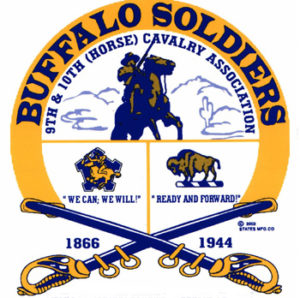
*On June 28, 1866, an Act of Congress authorized the creation of two cavalry and four infantry regiments, "which shall be composed of colored men." They were organized as the 9th and 10th Cavalry and the 38th through 41st Infantry. The 9th and 10th Cavalry would play a major role in the history of the West as the "Buffalo Soldiers." The congressional order required their officers to be white.
These were members of the American cavalry regiments of the U.S. Army who served in the western United States until 1896, mainly fighting Native Americans on the frontier. On September 21, 1866, the 9th Cavalry Regiment was activated at Greenville, LA, under the command of Colonel Edward Hatch, and the 10th Cavalry Regiment at Fort Leavenworth, KS, under the command of Colonel Benjamin Grierson. The 38th through 41st infantries (these four were later reduced to the 24th and 25th infantries) often fought alongside the cavalry regiments.
Both regiments were trained and equipped and began a long and proud history. African Americans have a long military history, dating back to the Revolutionary War. The all-black Tenth Cavalry is but one example.
After the American Civil War, the 9th, 10th, and 11th Buffalo Soldiers units were recognized as a superior fighting force. These cavalry units were primarily based in Texas, Oklahoma, Arizona, and New Mexico. The day had passed when ambitious officers avoided leading all-Black troops. In 1896, a young lieutenant John J. Pershing got his first command with the Tenth. It was here that he got the nickname "Black Jack.” According to some western historians, George Custer wanted nothing to do with the Black cavalry units, turning down command with them.
Additionally, it was widely believed that the tenth-longest-serving commander, General Benjamin H. Grierson, a brilliant and inventive officer, had been held back from promotion due to his close association with his Black troops. In 1916, a punitive mission headed by Pershing was to respond to the murder of eighteen people in Columbus, New Mexico, by Pancho Villa. Pershing had led the Buffalo Soldiers through the Spanish American War. When he took command of the Villa expedition, he specifically asked that the tenth, based at Fort Huachuca, Arizona, accompany him. However, the expedition came to nothing; it was the first campaign to use airplanes and motorized land vehicles. For over two decades, they conducted campaigns against Native American tribes, engaging in several skirmishes against such great Native Chiefs as Geronimo and Gall.
"Buffalo Soldiers" was the name given to the Black cavalrymen by the Plains Natives. The reasoning for the name is uncertain. One view is that the Natives saw a resemblance between the black man's hair and the buffalo's mane. Another view is that when a buffalo was wounded or cornered, it fought ferociously, displaying unusual stamina and courage. This was the same fighting spirit Indians saw in combat with Black cavalrymen. Since Natives held the buffalo in such high regard, it was felt that the name was not given in disrespect. The Buffalo Soldiers were noted for their courage and discipline. Drunkenness, a pervasive problem in the army, was rare; when nearly a third of white army enlistees deserted, the Black soldiers had the U.S. Army's lowest desertion and court-martial rates.
In nearly 30 years of frontier service, buffalo soldiers participated in almost 200 major and minor engagements. From 1870 to 1890, 14 Buffalo Soldiers were awarded the Medal of Honor, the Army's highest award for bravery. When not fighting, both regiments built forts and roads, installed telegraph lines, located water holes, escorted wagon trains and cattle drives, rode "shotgun" on the stagecoach and mail runs, and protected settlers from renegade Natives, outlaws, and Mexican revolutionaries. Elements of the 9th & 10th regiments fought in Cuba during the War with Spain. In 1941, the two regiments formed the 4th Cavalry Brigade and were commanded by General Benjamin O. Davis Sr. at Camp Funston, Kansas.
In 1944, the end came to the cavalry regiments, and the curtain was lowered on the long and glorious past of the "Buffalo Soldiers." The Baltimore Chapter of the Buffalo Soldiers Association hosted the 132nd Anniversary Reunion in 1998.